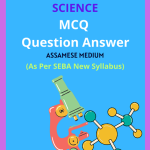Class 7 Science MCQ Chapter 15 Light Solutions in English Medium, Class 7 Science Multiple Choice Question Answer in English to each chapter is provided in the list so that you can easily browse throughout different chapters Class 7 Science MCQ Chapter 15 Light Notes and select need one.
Class 7 Science MCQ Chapter 15 Light
Also, you can read the SCERT book online in these sections Class 7 Science Objective Type Solutions by Expert Teachers as per SCERT (CBSE) Book guidelines. These solutions are part of SCERT All Subject Solutions. Here we have given Assam Class 7 Science MCQs Solutions in English for All Subject, You can practice these here.
Light
Chapter – 15
| MCQ |
1. A virtual image:
(a) Can be formed on the screen.
(b) Cannot be formed on the screen.
(c) Is formed only by the plane mirror.
(d) Is formed only by the convex mirror.
Ans: (b) Cannot be formed on the screen.
2. Which of the following would you prefer to use while reading small letters found in a dictionary?
(a) A concave mirror.
(b) A concave lens.
(c) A convex mirror.
(d) A convex lens.
Ans: (d) A convex lens.
3. The image of an object formed by a plane mirror is:
(a) Virtual.
(b) Real.
(c) Diminished.
(d) Upside down.
Ans: (a) Virtual.
4. A diverging mirror is:
(a) A plane mirror.
(b) A convex mirror.
(c) A concave mirror.
(d) None of the above.
Ans: (b) A convex mirror.
5. The image formed by a spherical mirror is virtual. The mirror will be:
(a) Concave.
(b) Convex.
(c) Either concave or convex.
(d) None of the above.
Ans: (c) Either concave or convex.
6. Convex mirror is used:
(a) As a rear view mirror in vehicles to help the driver check the view of the traffic behind them.
(b) As a reflector in street lamps to spread light over a wider area.
(c) Both (a) and (b).
(d) None of the above.
Ans: (c) Both (a) and (b).
7. The characteristics of images formed by a concave mirror are:
(a) The image is not always the same size as the object. It can be larger or smaller depending on the distance of the object to the mirror.
(b) The image is formed on the screen. Such a type of image that can be formed on a screen is called a real image.
(c) The image is inverted when the object is kept far from the mirror. When it is brought very close to the concave mirror, an erect and enlarged image is formed.
(d) All of the above.
Ans: (d) All of the above.
8. What type of image is formed by a plane mirror?
(a) Real and inverted.
(b) Virtual and erect.
(c) Real and erect.
(d) Virtual and inverted.
Ans: (b) Virtual and erect.
9. An inverted image larger than the object is formed by a:
(a) Convex lens.
(b) Concave lens.
(c) Both lenses.
(d) None of the above.
Ans: (a) Convex lens.
10. What is the characteristic of an image formed by a convex mirror?
(a) Real and magnified.
(b) Virtual and inverted.
(c) Erect and smaller than the object.
(d) Real and smaller than the object.
Ans: (c) Erect and smaller than the object.
11. Light travels in ____ lines:
(a) Straight.
(b) Reflections.
(c) Concave.
(d) Thicker.
Ans: (a) Straight.
12. What type of image does a concave mirror form when the object is very close to the mirror?
(a) Real and inverted.
(b) Virtual and erect.
(c) Real and magnified.
(d) Virtual and inverted.
Ans: (b) Virtual and erect.
13. The image formed in a plane mirror is ____ inverted:
(a) Concave.
(b) Convex.
(c) Laterally.
(d) Violet.
Ans: (c) Laterally.
14. What type of image is formed by a convex lens when the object is placed very close to the lens?
(a) Real and inverted.
(b) Virtual, erect, and magnified.
(c) Real, erect, and magnified.
(d) Virtual and smaller.
Ans: (b) Virtual, erect, and magnified.
15. If the image formed is always virtual, the mirror can be:
(a) Concave.
(b) Convex or plane.
(c) Laterally.
(d) Violet.
Ans: (b) Convex or plane.

Hi! my Name is Parimal Roy. I have completed my Bachelor’s degree in Philosophy (B.A.) from Silapathar General College. Currently, I am working as an HR Manager at Dev Library. It is a website that provides study materials for students from Class 3 to 12, including SCERT and NCERT notes. It also offers resources for BA, B.Com, B.Sc, and Computer Science, along with postgraduate notes. Besides study materials, the website has novels, eBooks, health and finance articles, biographies, quotes, and more.



